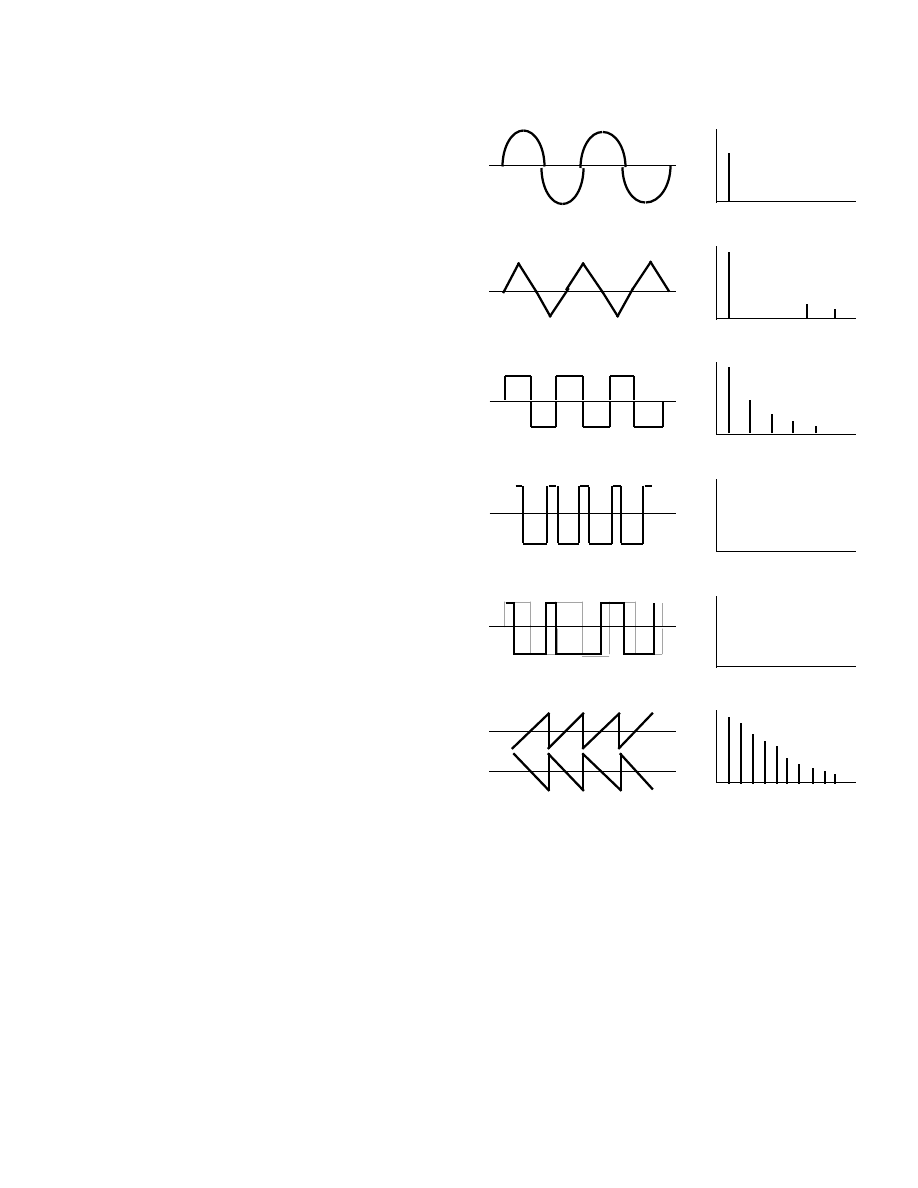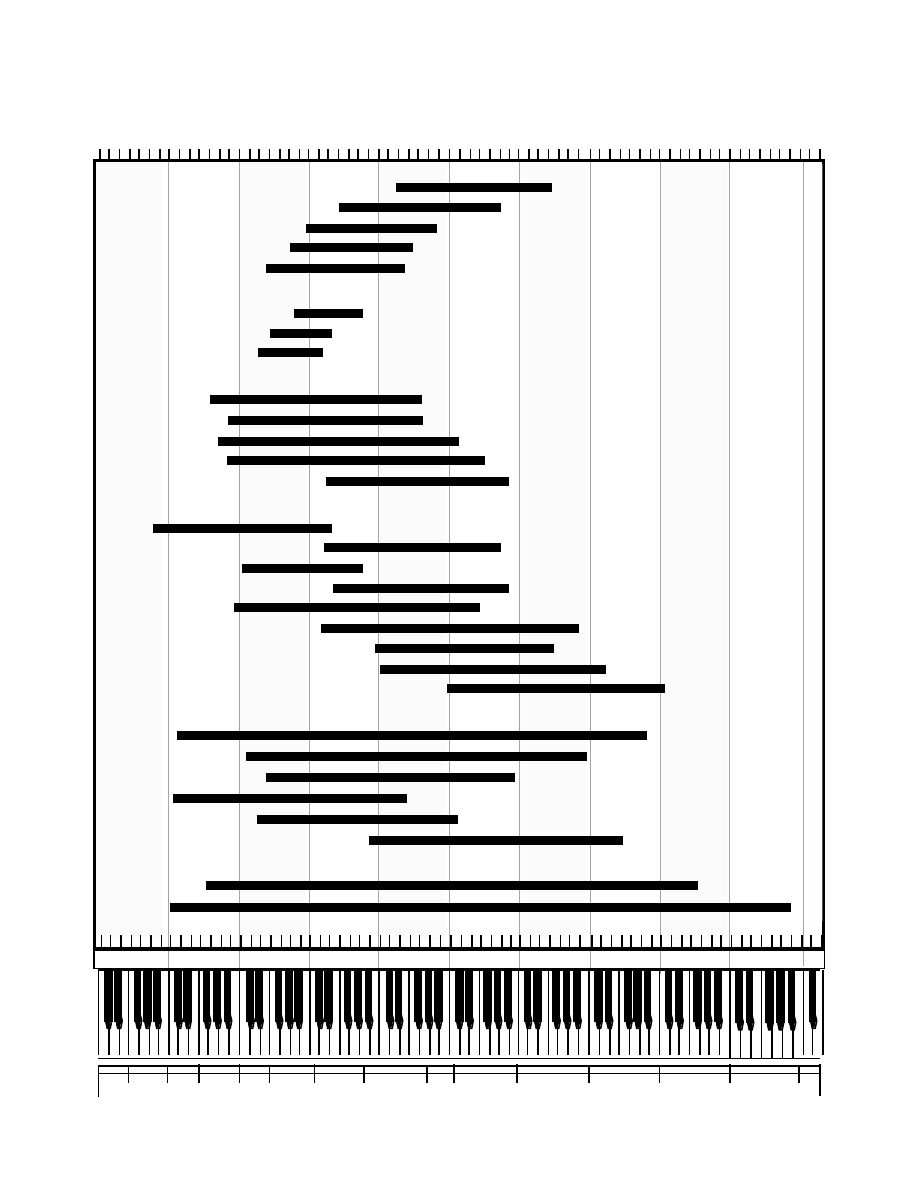ВУЗ: Казахская Национальная Академия Искусств им. Т. Жургенова
Категория: Учебное пособие
Дисциплина: Не указана
Добавлен: 03.02.2019
Просмотров: 11246
Скачиваний: 6

Appendix C
Each waveform contains a unique profile of har-
monics which determines its characteristic timbre.
The sine wave is a “pure” tone, i.e., one which
contains no harmonics. It is used in additive
synthesis to build up more complex sounds, in
analog synthesis for LFO modulation (such as
vibrato and tremolo), and also as an audio test
signal.
The sawtooth waveform, in contrast, contains all
the harmonics in the audio range, although not in
the same quantities. The loudness of each har-
monic is inversely proportional to its frequency,
so the harmonic with double the frequency of the
fundamental is at half the volume, three times
the frequency is at a third the volume, etc. This
makes an ideal waveform for producing fuller
sounds as it contains all of the frequencies re-
lated to the fundamental. The sawtooth may be
either rising or falling.
The square wave contains only odd-numbered
harmonics, again in inverse proportion to their
frequency. The hollow sound produced by the
square wave sounds much like the clarinet.
The square wave is actually a special case of the
pulse wave, where the negative and positive sec-
tions of the cycle are of equal duration. It is the
variable nature of the pulse wave which makes it
interesting in sound synthesis. Not only are
there infinite variations on the harmonic spectra
available, but the pulse width may be swept.
This is known as pulse width modulation. See
PWM. The width parameter refers to the dura-
tion of the positive component in proportion to
that of the complete cycle.
The square, sawtooth, and pulse waves contain
whole families of frequencies in harmonic series.
This means that the human ear perceives these
sounds as a single pitch whose tonal quality is
determined by the exact mix of harmonics pre-
sent.
The triangle wave contains the fundamental and
a few high harmonics. Normally found only in
analog synthesis as a variant on sine wave
modulation, but can be used as an alternative to
the sine wave for LFO modulation, producing
exponential, rather than linear variations.
F 2 3 4 5 6 7 8 9 etc.
Harmonic Content
F 2 3 4 5 6 7 8 9 etc.
Harmonic Content
F 2 3 4 5 6 7 8 9 etc.
Harmonic Content
F 2 3 4 5 6 7 8 9 etc.
Harmonic Content
F 2 3 4 5 6 7 8 9 etc.
Harmonic Content
F 2 3 4 5 6 7 8 9 etc.
Harmonic Content
Varies with width
Varies with time
Sine Wave
Triangle Wave
Square Wave
Pulse Wave
Pulse Width Modulation
Sawtooth Wave
Rising
Falling


Appendix D
20
30
40
65
80
150
200
400 500
1K
2K
4K
8K
16K
CDEFGAB
CDEFGAB
CDEFGAB
CDEFGAB
CDEFGAB
CDEFGAB
CDEFGAB
CDEFGAB
CDEFGAB
CDEFGAB
C
20
30
40
65
80
150
200
400 500
1K
2K
4K
8K
16K
Soprano
Contralto
Tenor
Baritone
Bass
Small
Medium
Large
Tuba
Bass Trombone
Tenor Trombone
French Horm
B-Trumpet
Contrabassoon
Alto Saxophone
Bass Clarinet
English Horn
Bassoon
B-Clarinet
Oboe
Flute
Piccolo
Harp
Viola
Guitar
Bass
Cello
Piano
Pipe Organ
Violin
Frequency (Hz)
Singing Voice
Kettle Drums
Brass
Woodwinds
Strings

Bibliography
0.
Buick, Peter and Vic Lennard, Music Technology Reference Book. PC Publishing, Tonbridge, Kent, UK, 1995.
If you have any use at all for this dictionary, you need one of these. Several, in fact
.
1.
Evans, Alvis J., Making Sense of Sound: The Basics of Audio Theory and Technology. Prompt Publications, Indianapolis, IN, 1992 (2nd Ed.)
2.
Petersen, George and Steve Oppenheimer, Tech Terms: A Practical Dictionary for Audio and Music Production. EMBooks, Emeryville, CA,
1993.
3.
White, Glenn D, The Audio Dictionary. University of Washington Press, Seattle, 1991 (2nd ed.) Very technical and very good. Excellent
graphics, excellent sense of humor, excellent appendices. Only criticism: needs to be updated to include digital music, including MIDI.
4.
Wilkie, Godric. The Studio Musicians Jargonbuster. Musonix Publishing, London, 1993. A good, entertaining, introductory dictionary.
5.
Cummings, David, Ed., The Hutchinson Encyclopedia of Music. Helicon Publishing, Ltd., Oxford, England, 1995.
6.
Sinclair, Ian R. Introducing Digital Audio: CD, DAT and Sampling. PC Publishing, Tonbridge, Kent, UK, 1988 and 1992. Extremely
technical, extremely detailed explication of CD and DAT formats, standards, and production.
7.
Wadhams, Wayne. Dictionary of Music Production and Engineering Terminology. Schirmer Books, New York, 1988. Basically a good
book, especially for anyone contemplating doing sound-for-film. Unfortunately, there are lots of errors, the book is poorly cross-referenced, and
in parts, just inscrutable.
8.
"Music & Computers" Magazine. Miller Freeman, Inc., San Francisco, CA. 94107.
9.
"Keyboard" Magazine. Keyboard, San Mateo, CA. 94402.
10. "Mix" Magazine. 6400 Hollis St., #12, Emeryville, CA 94608, especially "Whats a Binky?" March, April, and June 1999, by Larry Blake.
11. "Recording" Magazine. Music Maker Publications, Inc., 7318 Topanga Canyon Blvd., Suite 200, Canoga Park, CA 91303.
12. "Sound on Sound" Magazine. Media House, Burrel Road, St. Ives, Cambs. UK, PE17 4LE.
13. "Sound on Stage" Magazine. Media House, Trafalgar Way, Bar Hill, Cambs. UK, CB3 8SQ.
14. Timeline. SMPTE Made Simple. Timeline Vista, USA. 1996. Such that SMPTE timecode can ever be simple, I guess this is it.
15. White, Paul. The Sound on Sound Book of Music Technology: A Survivors Guide. Sanctuary Publishing Ltd., London, 1997.

Feedback
Any comments, questions, additions, or critiques on any aspect of this dictionary, please feel free to contact the following people:
Sandy Lerner
author
Sandy@xkl.com
Len Bosak
engineer, cisco co-founder
Bosak@xkl.com
Dan Shores
engineer, musician
SonoLuminus@xkl.com
Allan Kent
editor
allank@quixnet.net